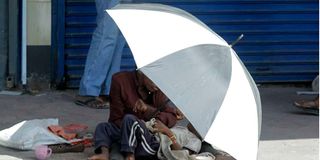Kenya poverty to fall to five-year low next year

A street family on Nkrumah Road in Mombasa.
What you need to know:
- World Bank projects that Kenya’s poverty will fall to 33.4 percent in 2022, below the pre-crisis level of 34.4 per cent in 2019.
- While the pandemic stalled growth in 2020, the economy has recovered, and output is well above pre-pandemic levels.
Kenya’s poverty rate is projected to drop to a five-year low in 2023 thanks to better weather and export growth, the World Bank has said.
It said that with GDP growth projected to average 5.2 per cent over the 2022-2024 window, growth in real per capita incomes will help reverse the rising poverty rates caused by the Covid-19 pandemic.
World Bank projects that Kenya’s poverty will fall to 33.4 percent in 2022, below the pre-crisis level of 34.4 per cent in 2019.
“Kenya’s economy was severely disrupted by the Covid-19 shock but it has staged a strong recovery, and the poverty rate is projected to fall below its pre-pandemic level in 2022,” the World Bank said in its latest outlook report.
Kenya’s poverty rate is anticipated to dip to 32.5 per cent next year and 31.6 per cent in 2024.
“The baseline projections assume that normal rains support good agricultural harvests to drive food processing, sustain export growth, help anchor inflation expectations, and support households’ consumption,” the World Bank said.
While the pandemic stalled growth in 2020, the economy has recovered, and output is well above pre-pandemic levels.
The economy grew by an estimated 6.7 per cent in 2021, supported by a strong recovery of the services sector, particularly education, and growth in manufacturing and construction. Agricultural output, however, contracted by 1.5 per cent in 2021, due to below-average rains.
The disruption caused by the omicron variant of Covid-19 led to some moderation of economic activity in the fourth quarter of 2021.
The fiscal out-turn in the first half of the financial year 2021/22 improved, driven largely by the economic recovery, a strong rebound in revenues, and new tax policy and administration measures implemented under the government’s medium-term fiscal consolidation programme.
Total expenditures have remained broadly steady at 10.8 per cent of GDP in first half of the year, with an increase in recurrent spending being offset by reduced development spending and below-target transfers to county governments.
As a result, the fiscal deficit in the first half of the financial year 2021/22 decreased to 2.5 per cent of GDP from 3.2 per cent a year earlier.





